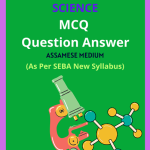Class 8 Science MCQ Chapter 5 Coal and Petroleum Solutions in English Medium, Class 8 Science Multiple Choice Question Answer in English to each chapter is provided in the list so that you can easily browse throughout different chapters Class 8 Science MCQ Chapter 5 Coal and Petroleum Notes and select need one.
Class 8 Science MCQ Chapter 5 Coal and Petroleum
Also, you can read the SCERT book online in these sections Class 8 Science Objective Type Solutions by Expert Teachers as per SCERT (CBSE) Book guidelines. These solutions are part of SCERT All Subject Solutions. Here we have given Assam Class 8 Science MCQs Solutions in English for All Subject, You can practice these here.
Coal and Petroleum
Chapter – 5
| MCQ |
1. Which of the following is a major component of natural gas?
(a) Ethanol.
(b) Methane.
(c) Butane.
(d) Propane.
Ans: (b) Methane.
2. Which type of coal is used primarily in electricity generation?
(a) Peat.
(b) Lignite.
(c) Bituminous.
(d) Anthracite.
Ans: (c) Bituminous.
3. Petroleum is extracted from the earth using:
(a) Hydraulic fracturing.
(b) Surface mining.
(c) Shaft mining.
(d) Drilling.
Ans: (d) Drilling.
4. Which process is used to separate different hydrocarbons in crude oil?
(a) Combustion.
(b) Fractional Distillation.
(c) Electrolysis.
(d) Filtration.
Ans: (b) Fractional Distillation.
5. Which environmental issue is directly associated with coal mining?
(a) Global warming.
(b) Ozone layer depletion.
(c) Land subsidence.
(d) Deforestation.
Ans: (c) Land subsidence.
6. Which type of coal has the lowest carbon content?
(a) Peat.
(b) Bituminous.
(c) Anthracite.
(d) Lignite.
Ans: (a) Peat.
7. Which of the following is a by-product of petroleum refining?
(a) Nitrogen.
(b) Carbon Dioxide.
(c) Gasoline.
(d) Water.
Ans: (c) Gasoline.
8. Which substance is primarily responsible for acid rain from coal combustion?
(a) Methane.
(b) Nitrogen Oxides.
(c) Carbon Monoxide.
(d) Sulphur Dioxide.
Ans: (d) Sulphur Dioxide.
9. In which country is the largest coal deposit found?
(a) USA.
(b) Australia.
(c) China.
(d) Russia.
Ans: (d) Russia.
10. What is the process of converting coal into a gas for fuel called?
(a) Gasification.
(b) Liquefaction.
(c) Combustion.
(d) Pyrolysis.
Ans: (a) Gasification.
11. What is the primary use of petroleum in transportation?
(a) Propane.
(b) Diesel.
(c) Coal Tar.
(d) Kerosene.
Ans: (b) Diesel.
12. Which of the following is a common use of coal tar?
(a) Fuel for vehicles.
(b) Production of plastics.
(c) Road construction.
(d) Water purification.
Ans: (c) Road construction.
13. What type of coal is also known as “brown coal”?
(a) Bituminous.
(b) Lignite.
(c) Anthracite.
(d) Peat.
Ans: (b) Lignite.
14. Which of the following is NOT a typical use of natural gas?
(a) Heating.
(b) Electricity generation.
(c) Propellant.
(d) Metal extraction.
Ans: (d) Metal extraction.
15. Which chemical compound is predominantly found in coal gas?
(a) Carbon Monoxide.
(b) Nitrogen Dioxide.
(c) Methane.
(d) Sulphur Dioxide.
Ans: (c) Methane.

Hi! my Name is Parimal Roy. I have completed my Bachelor’s degree in Philosophy (B.A.) from Silapathar General College. Currently, I am working as an HR Manager at Dev Library. It is a website that provides study materials for students from Class 3 to 12, including SCERT and NCERT notes. It also offers resources for BA, B.Com, B.Sc, and Computer Science, along with postgraduate notes. Besides study materials, the website has novels, eBooks, health and finance articles, biographies, quotes, and more.




